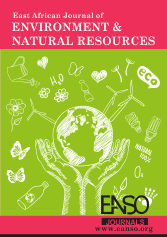Assessing the Impact of Flooding on Livelihoods in Kamonyi District, Rwanda
الملخص
The general objective of the study was to investigate the impact of flooding on the livelihood of the Community in Kamonyi District. The Specific objectives were: to establish the causes of flooding, to assess the occurrence and intensity of flooding, to evaluate the livelihood of the community of Kamonyi District, to investigate the effect of flooding on biodiversity and to examine the coping mechanism. This study adopted a descriptive survey research design. The targeted population for this study included 838 farmers and 6 local leaders. However, given that this population was huge, sampling was conducted of this target population. The simple random sampling was applied in the selection of respondents from the farmers who use this marshland in cultivation, whereby 75 respondents were used as a sample and the Purposive sampling was used to select local leaders. Both primary and secondary data were used. Data collection methods included questionnaires, interview schedules and document review. In relation to the first specific objectives, Table 6 indicates that massive rainfall was identified as a major cause of flooding, accounting for 44.94%. Hydrological changes were also reported as a contributing factor at 14.50%. It is important for farmers to understand and follow advice given by local leaders regarding flood prevention in their cultivation areas. The sector officer in charge of agriculture must ensure that tools reserved for the development of modern agriculture are effectively utilised with proper distribution and allocation of resources
التنزيلات
المراجع
Ajayi. (2007). Flooding and biodiversity sustainability in Miombe woodland. Dar es Salam: University of Dar es-Salam.
Azamia. (2013). Source of data in modern research, 3rd Volume. Lagos, Nigeria: Mc Green HALL Publisher.
Baker. (1988). The research enhancement. New York: Wiliamton Press.
Ballesteros-Cánovas, J. A., Stoffel, M., Corona, C., Schuwirth, N., Gurumendi, M., & Rohrer, M. (2020). Recent flood hazards in Kashmir put into context with millennium-long historical and tree-ring records.
Daniel, N. O., & Udo, A. J. (2019). Impact of flood on agricultural production in rural communities of Akwa Ibom State, Nigeria. International Journal of Research and Scientific Innovation (IJRSI), 6(3), 13–17
Gall. (1996). Handling Nonresponse In Social. Journal of Agricultural Education, pp45-56.
Giorgi. (2009). Floods and crop: Challenges and implications. Nebraska: University of Toronto.
Grinnell and Williams. (1990:41). Research in social work (éd. 1st Edition a primer). USA.
Hornby. (1963). Source of data and the research execution. Berlin: Berlin Wall Mass Publication.
Kakooza. (1996). Sample size and research enhancement. Paris, France: La Loirre Parrain.
Kaooza. (1996: 11). How to understand and address the cultural aspects and consequences of diagnosis of epilepsy, including stigma.
Kamonyi administrative report, 2019 on Evaluation of District Development strategy, p 64-71
Kendall. (1992). Questionnaire as tool of research data collection. Accra: Accra News Publisher.
Komolafe, I. B., S. A. Adedokun, and S. S. Olajide. "Assessment of Heavy Metal Contamination in Soils and Vegetables Grown Around Automobile Workshops in Akure, Ondo State, Nigeria." Journal of Environmental Protection 6, no. 3 (2015): 209-17
Mahmood. (2017). Implication of the uncertain environment on cropping sequence. La Haye: Polish Publisher.
Manrich, J. B. (1990). The population analysis and research extraction. Munich, Germany: The wizland Pres.
Marlow. (1999). Purposive sampling in research. Maryland.
Mbaaga, F. M. (1990). The sample selection and analytical practicability. Munich: Waland.
McCusker and Carr. (2006). The impacts of soil denudation on food availability and use. New Orleans: University of New Orleans.
Nkuriza. (2019). Study on flooding and waster water management options for Rwanda. Kigali: A paper presented in the conference of African Development Bank.
Nott. (2017). Flooding and food security in tropical areas. Wellington: Adventure Pub.
Petit-Boix. (2017). Impacts of flooding on biodiversity conservation. London: LSE.
Punch, K. F. (2006). Developing effective research proposals (2nd ed.). SAGE Publications.
REMA. (Rwandan environmental outlook). 2012. Kigali: REMA.
Rezende. (2021). The climate change and the environmental degradation. Arkansas: University of New Orleans.
Tabiri, M. (2015). Causes and impacts of flooding in Accra: An opinion from a flood affected person in a flood prone area of Accra. Urban and Regional Planning Review, 2, 48–62.
Ujene, A. A., & Oguike, U. C. (2020). Flood Risk Assessment of Selected Communities in Aba North Local Government Area, Abia State, Nigeria. International Journal of Research and Innovation in Social Science (IJRISS), 4(9), 42-50
Viernes. (2009). Data collection techniques. Paris: Publication La viellette.
Yaro, J. A. (2004). The impact of agricultural practices on environmental degradation in Africa. Journal of Sustainable Development in Africa, 6(2), 24–40.
الحقوق الفكرية (c) 2025 Emmanuel Tuyisenge, Jonas Nzabamwita, PhD

هذا العمل مرخص حسب الرخصة Creative Commons Attribution 4.0 International License.




























